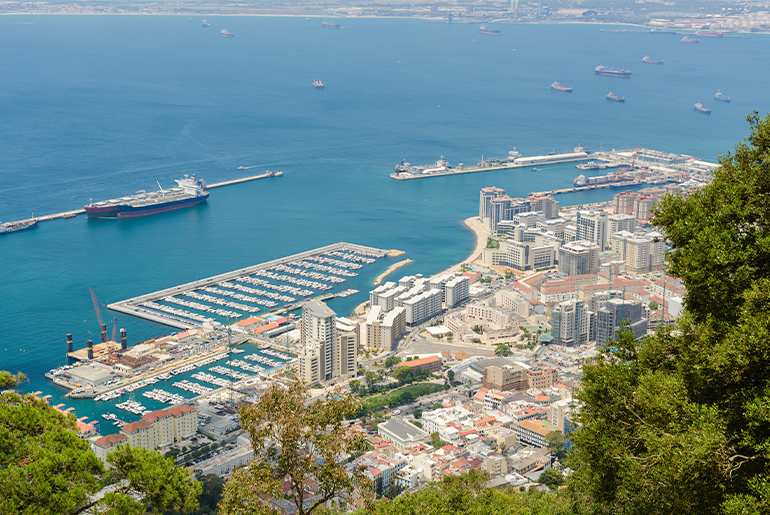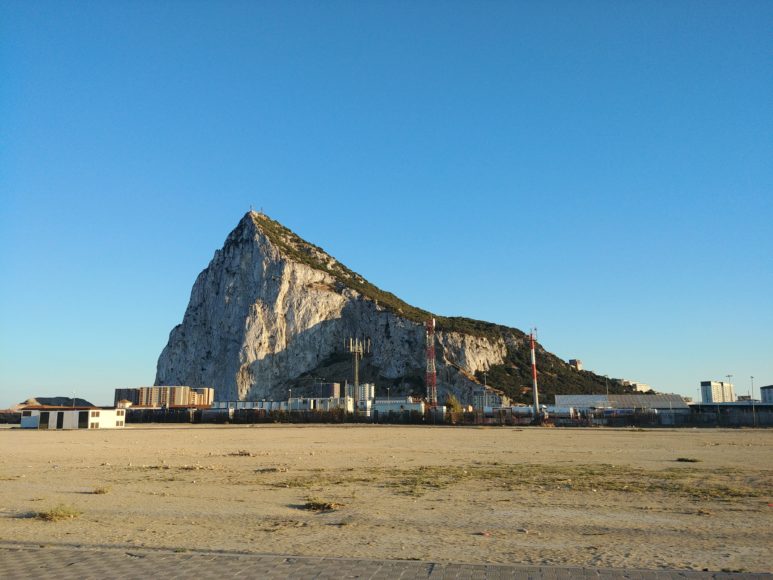There is punk rock, there is igneous rock and then there is Gibraltar, the British Overseas Territory incongruously attached to Spain at the southern tip of the Iberian peninsula. Two miles long by a barely a mile wide, the stubborn, recalcitrant, headstrong Rock of Gibraltar has become a byword for something unchanging and dependable, somewhere that refuses to change regardless of fad, fashion or the prevailing wind – which is undoubtedly why the Prudential insurance company uses the Rock in its logo.
Ceded to Great Britain in perpetuity at the end of the War of Spanish Secession, in 1713, Gibraltar has roughly the same relationship to the United Kingdom as Guam does to the United States — although it is 100th of Guam’s size. Take a daily stroll along Main Street and after a couple of days you will recognize virtually every face in town. And they will know you, too, or make it their business to — Gibraltarians are a curiously curious, disarmingly parochial lot. Despite the incongruity of palm trees and near year-round sunny skies, Gibraltar has the bizarre feel of an ungentrified, deeply provincial English town, where most of the 30,000 inhabitants speak Spanish as well as English, seesawing seamlessly between the two.
And with its location at Western Europe’s southernmost point, almost brushing Africa (Tangier, in Morocco, is a 15-minute flight away,) it’s exciting, too. Arrive by plane at Gibraltar’s pint-sized airport, with a runway that is built on reclaimed land and bisects the territory, and you get to experience one of the world’s most thrilling landings. Clear customs and immigration and you will cross the runway again, this time as you drive or walk into town along Winston Churchill Avenue. It takes just five minutes on foot.
Cruise ships call here, but Gibraltar is no Venice or Monaco. There’s no Bulgari or Van Cleef & Arpels on Main Street, only pubs, liquor stores, perfumeries, souvenir shops and knock-off pashmina stores galore, where you pay for your purchases in Gibraltar or British pounds sterling. You’ll also find a branch of Marks & Spencer, the redoubtable retailer of underwear, clothing and comestibles, which is a mainstay of British life, along with a clutch of international banks, evincing Gib’s status as a financial services center. On the side streets leading off Main Street, the lawyers and accountants huddle in their sinuous, air-conditioned offices, cheek by jowl with pizzerias, fish-and-chip shops and hairdressing salons — latest style, around 1980. Charles and Diana may have started their honeymoon here in 1981, but no one could ever accuse Gibraltar of being glamorous.
A melting pot of Britons, Italians, Indians, Moroccans, Maltese and Jews, Gibraltar is a time-warped, cohesive mishmash, which not only give it its unique identity but also its charm. Dirty and unloved in parts, blighted in others by 1960s civic housing, Gibraltar boasts no lip-smacking, indigenous cuisine or glamorous beaches. But set this against jaw-dropping views, cobbled streets redolent with history, Georgian and Regency domestic architecture, a graveyard in the center of town where sailors from the Battle of Trafalgar lay buried and — not forgetting a couple of swanky new marinas — the place, to my mind, is utterly irresistible.
Gibraltar’s grande dame hotel, The Rock, was built in 1932 by Scottish aristocrat John Crichton-Stuart, fourth Marquess of Bute. Reclining in a rattan armchair on the veranda here, sipping your pink gin, you may well feel like a character out of a Somerset Maugham short story or Graham Greene novel. With its Art Deco features, the dear old Rock Hotel also feels like a backdrop for an Agatha Christie whodunnit — not that I’m suggesting for a moment that anything as indelicate as murder could happen in so romantic or lovely a spot.
On the contrary, the hotel is a very bastion of decorum. It is clean and comfortable, the staff is kind and the food is, well, decent. As for the views — the Spanish coast to the east and west, Morocco and the Rif mountains to the south — they could melt a heart of stone. And add to this a lovely swimming pool, set in a mature garden (actually adjoining Gibraltar’s very own Botanical Gardens,) and for many old Gibraltar “hands,” The Rock Hotel is still the only place to stay.

Of course, there are alternatives. At the high end, the yacht-floating Sunborn hotel, anchored in the old Port of Gibraltar, gives you a kind of maritime experience, fitting for this storied place whose history is so tied to the sea. Expect all iterations of luxury here, including a terrific gym, a spa and even a casino. At the budget end, the cheap ’n’ cheerful Engineer Guest House, with a good central location, offers more of an authentic, local experience. And somewhere in the middle is the well-established, four-star Caleta Hotel, located away from the action on the quieter, eastern side of the Rock.
As for what to do in Gibraltar, St. Michael’s Cave, a network of more than 150 Neolithic limestone caves in the Upper Rock Nature Reserve, attracts more than a million visitors a year. There are also 18th-century tunnels to explore (expanded during World War II), a cable car to ride to the top of the Rock, the Moorish Castle to visit, and, of course, a hike or drive to hang out with Gibraltar’s famous Barbary apes — which are in fact macaques. Legend holds that while there is still a macaque on Gibraltar, the territory will remain under British rule.
A month before the start of the pandemic, in February last year, I sat outside Costa Coffee on Gibraltar’s Casemates Square one afternoon, enjoying an afternoon cup of tea with a dear Gibraltarian friend — indeed, a friend since childhood. As people came into view, they would wave a greeting at said friend, who in turn would wave back as they passed and disappeared from sight. “They say hello, you say goodbye,” I commented. “Exactly,” said my friend, “just like the Beatles song. This is a sort of ritual in Gibraltar. In fact, I sometimes wonder if this is where John Lennon got the idea for the song.”
Nice idea, but in fact he didn’t. I looked into it and the song, “Hello, Goodbye,” with lyrics by Paul McCartney, predates Lennon and Yoko Ono’s Gibraltar wedding by a couple of years. They were married in a room at The Rock Hotel in March, 1969.
Still, it’s a fitting anthem for Gibraltar, which for all its dependability, has an ephemeral, “ships passing in the night” quality to it. Either way, there is something about Gibraltar — which has survived naval battles, sieges and blockades, and has come through Covid virtually untouched — which gets under my skin.
Chances are, it will get under yours, too.
For more, visit rockhotelgibraltar.com, sunborngilbraltar.com and caletahotel.com.




